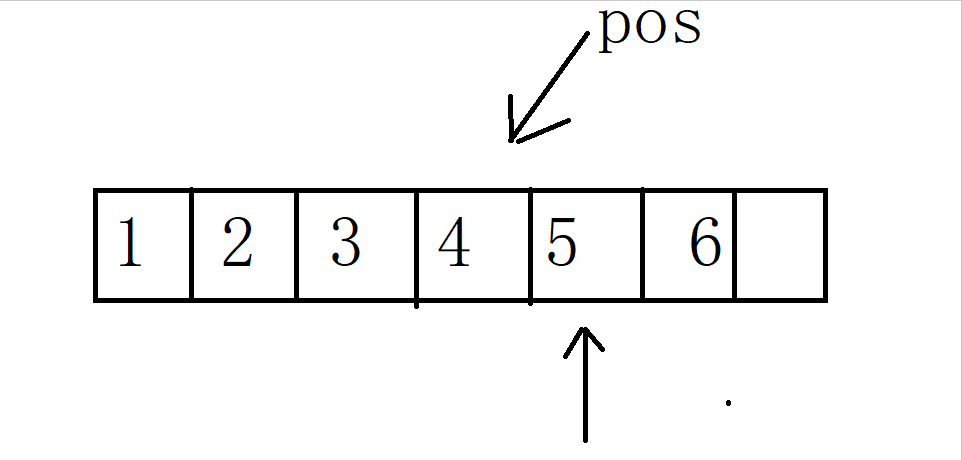数据结构-顺序表
数据结构-顺序表
- 线性表
- 顺序表的概念和结构
-
- 静态顺序表和动态顺序表
- 接口的实现
-
- 顺序表的初始化
- 顺序表的打印
- 顺序表的销毁
- 顺序表的增容
- 顺序表的尾插
- 顺序表的尾删
- 顺序表的头插
- 顺序表的头删
- 顺序表的任意位置插入
- 顺序表的任意位置删除
- 顺序表中元素的查找
- 完整代码
线性表
线性表是n个具有相同特性的数据元素的有限序列。它是一种数据结构。常见的线性表有:顺序表,链表,栈,队列,字符串等。线性表在逻辑上是线性结构,也就是说,从逻辑的角度来看,它是连续的一条直线。但是在物理结构上不一定是连续的,通常以数组和链式结构的形式存储。这里我们主要了解顺序表。
顺序表的概念和结构
顺序表是用一段物理地址连续的存储单元依次存储元素的线性结构。一般情况下采用数组的形式进行存储。在数组上完成数组的增删查改。

顺序表一般可以分为静态顺序表和动态顺序表。
静态顺序表和动态顺序表
静态顺序表的数组长度是固定的。如下:
#define N 10000
typedef int SLDataType;
struct SeqList
{
SLDataType a[N];
int size;
};
这里#define 对数组的长度10000用N来替换;typedef对int数据类型重新定义为一个新的名字SLDataType;SeqList就是我们的顺序表,它包括数组和当前的数据表的长度size。
由于静态顺序表的数组大小是固定的,当数组大小不大时,数据增加,可能存放不下;当数组大小大的时候,又会造成空间的浪费。因此,静态顺序表不常用。常用动态顺序表,如下:
//动态
typedef int SLDataType;
#define INIT_CAPACITY 4
typedef struct SeqList
{
SLDataType* a;
int size;//当前数据的个数
int capacity;//容量
}SL;
这里typedef对int数据类型重新定义为一个新的名字SLDataType;SeqList就是我们的顺序表,它包括SLDataType* a指针和当前的数据的个数size,顺序表的容量capacity;对顺序表struct SeqList数据类型重新定义为一个新的名字SL。
接口的实现
顺序表的初始化
初始化:malloc函数申请空间为数组所占用的空间,size置零,给定初始容量为4
这里我们采用指针进行函数传参。
#define INIT_CAPACITY 4
void SLInit(SL* ps)
{
ps->a = (SLDataType*)malloc(sizeof(SLDataType*) * INIT_CAPACITY);
if(ps->a == NULL)
{
perror("malloc fail");
return ;
}
ps->size = 0;
ps->capacity = INIT_CAPACITY;
}
顺序表的打印
顺序表的打印就是打印出数组中的元素
void SLPrint(SL* ps)
{
for (int i=0;i<ps->size;i++)
{
printf("%d ",ps->a[i]);
}
printf("\n");
}
顺序表的销毁
动态空间释放,指针置NULL;变量归0
void SLDestroy(SL* ps)
{
free(ps->a);
ps->a = NULL;
ps->capacity = ps->size = 0;
}
顺序表的增容
当元素个数size大于等于顺序表中的capacity时,就需要增容。
我们使用realloc函数对其增容,增容后,指针需要重新赋值,capacity变量值需要改变。
void SLCheckCapacity(SL* ps)
{
if (ps->capacity == ps->size)
{
SLDataType* temp = (SLDataType*)realloc(ps->a, sizeof(SLDataType*) * ps->capacity * 2);
if (temp == NULL)
{
perror("realloc fail");
return;
}
ps->a = temp;
ps->capacity *= 2;
}
}
顺序表的尾插
尾插比较简单,只需要size++后,给数组赋值即可。
void SLPushBack(SL* ps, SLDataType x)
{
if (ps->capacity==ps->size)
{
SLDataType* temp = (SLDataType*)realloc(ps->a, sizeof(SLDataType*) * ps->capacity * 2);
if (temp == NULL)
{
perror("realloc fail");
return;
}
ps->a = temp;
ps->capacity *= 2;
}//这里也可以直接调用SLCheckCapacity函数
ps->a[ps->size++] = x;
}
顺序表的尾删
这里只需要size–动作,不需要去计较最后一个元素是否已从内存中清空;但是需要检查size,即顺序表中要存在数据。
void SLPopBack(SL* ps)
{
assert(ps->size>0);
ps->size--;
}
顺序表的头插
在顺序表的头部插入数据,就是意为着所有的元素都要后移1位。如果从前面的元素开始移动数据,则会覆盖掉后面的元素。因此,我们从最后一个元素向后移动数据,一直到指针end指向0。动画如下:

void SLPushFront(SL* ps, SLDataType x)
{
assert(ps);
SLCheckCapacity(ps);
int end = ps->size - 1;
while (end>=0)
{
ps->a[end + 1] = ps->a[end];
end--;
}
ps->a[0] = x;
ps->size++;
//SLInsert(ps, 0, x);
}
顺序表的头删
在顺序表的头部删除数据,只需要将后面的元素逐步覆盖掉前一个元素,指针从1开始,到size-1结束。动画如下:

void SLPopFront(SL* ps)
{
assert(ps);
assert(ps->size>0);
int begin = 1;
while (begin<ps->size)
{
ps->a[begin - 1] = ps->a[begin];
begin++;
}
ps->size--;
//SLErase(ps, 0);
}
顺序表的任意位置插入
和头插的思想一样,在被插入的位置和以后的位置的元素都要后移1位,仍然是从最后一个元素后移,指针由size-1变化到pos。动画如下:

void SLInsert(SL* ps, int pos, SLDataType x)
{
assert(ps);
assert(pos>=0&&pos<=ps->size);
SLCheckCapacity(ps);
int end = ps->size - 1;
while (end>=pos)
{
ps->a[end + 1] = ps->a[end];
end--;
}
ps->a[pos] = x;
ps->size++;
}
因为是任意位置的插入,因此,对于头插和尾插都可以用SLInsert函数实现,如下:
SLInsert(ps,ps->size,x);//尾插
SLInsert(ps, 0, x);//头插
顺序表的任意位置删除
与头删的思想一样,只需要将被删除位置后面的元素依次覆盖掉前面的元素。动画如下:

void SLErase(SL* ps, int pos)
{
assert(ps);
assert(pos>=0&&pos<ps->size);
int begin = pos + 1;
while (begin<ps->size)
{
ps->a[begin-1] = ps->a[begin];
begin++;
}
ps->size--;
}
因为是任意位置的删除,所以头删和尾删也可以用SLErase函数表示,如下:
SLErase(ps,ps->size-1);//尾删
SLErase(ps, 0);//头删
顺序表中元素的查找
这里采用遍历的方法来查找元素,如下:
int SLFind(SL* ps, SLDataType x)
{
assert(ps);
for (int i=0;i<ps->size;i++)
{
if (ps->a[i]==x)
{
return i;
}
}
return -1;
}
完整代码
主程序:
#define _CRT_SECURE_NO_WARNINGS 1
#include "SeqList.h"
void TestSeList1()
{
SL s;
SLInit(&s);
SLPushBack(&s, 1);
SLPushBack(&s, 2);
SLPushBack(&s, 4);
SLPushBack(&s, 6);
SLPushBack(&s, 8);
SLPopBack(&s);
SLPopBack(&s);
SLPopBack(&s);
SLPushFront(&s, -1);
SLPushFront(&s, -2);
SLPushFront(&s, -3);
SLPopFront(&s);
SLPopFront(&s);
SLPopFront(&s);
SLInsert(&s, 1, 11);
SLInsert(&s, 2, 12);
SLErase(&s, 2);
SLErase(&s, 1);
SLPushBack(&s, 100);
SLPushFront(&s, -100);
SLPopBack(&s);
SLPopFront(&s);
int ret=SLFind(&s,1);
printf("%d\n",ret);
SLPrint(&s);
SLDestroy(&s);
}
int main()
{
TestSeList1();
return 0;
}
函数的定义
#define _CRT_SECURE_NO_WARNINGS 1
#include "SeqList.h"
void SLInit(SL* ps)
{
ps->a = (SLDataType*)malloc(sizeof(SLDataType*) * INIT_CAPACITY);
if(ps->a == NULL)
{
perror("malloc fail");
return ;
}
ps->size = 0;
ps->capacity = INIT_CAPACITY;
}
void SLDestroy(SL* ps)
{
free(ps->a);
ps->a = NULL;
ps->capacity = ps->size = 0;
}
void SLPrint(SL* ps)
{
for (int i=0;i<ps->size;i++)
{
printf("%d ",ps->a[i]);
}
printf("\n");
}
void SLCheckCapacity(SL* ps)
{
if (ps->capacity == ps->size)
{
SLDataType* temp = (SLDataType*)realloc(ps->a, sizeof(SLDataType*) * ps->capacity * 2);
if (temp == NULL)
{
perror("realloc fail");
return;
}
ps->a = temp;
ps->capacity *= 2;
}
}
void SLPushBack(SL* ps, SLDataType x)
{
if (ps->capacity==ps->size)
{
SLDataType* temp = (SLDataType*)realloc(ps->a, sizeof(SLDataType*) * ps->capacity * 2);
if (temp == NULL)
{
perror("realloc fail");
return;
}
ps->a = temp;
ps->capacity *= 2;
}
ps->a[ps->size++] = x;
//SLInsert(ps,ps->size,x);
}
void SLPopBack(SL* ps)
{
assert(ps->size>0);
ps->size--;
//SLErase(ps,ps->size-1);
}
void SLPushFront(SL* ps, SLDataType x)
{
//assert(ps);
//SLCheckCapacity(ps);
//int end = ps->size - 1;
//while (end>=0)
//{
// ps->a[end + 1] = ps->a[end];
// end--;
//}
//ps->a[0] = x;
//ps->size++;
SLInsert(ps, 0, x);
}
void SLPopFront(SL* ps)
{
assert(ps);
assert(ps->size>0);
int begin = 1;
while (begin<ps->size)
{
ps->a[begin - 1] = ps->a[begin];
begin++;
}
ps->size--;
//SLErase(ps, 0);
}
void SLInsert(SL* ps, int pos, SLDataType x)
{
assert(ps);
assert(pos>=0&&pos<=ps->size);
SLCheckCapacity(ps);
int end = ps->size - 1;
while (end>=pos)
{
ps->a[end + 1] = ps->a[end];
end--;
}
ps->a[pos] = x;
ps->size++;
}
void SLErase(SL* ps, int pos)
{
assert(ps);
assert(pos>=0&&pos<ps->size);
int begin = pos + 1;
while (begin<ps->size)
{
ps->a[begin-1] = ps->a[begin];
begin++;
}
ps->size--;
}
int SLFind(SL* ps, SLDataType x)
{
assert(ps);
for (int i=0;i<ps->size;i++)
{
if (ps->a[i]==x)
{
return i;
}
}
return -1;
}
函数的声明
#pragma once
#include